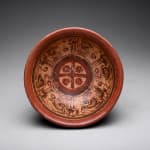Copador Style Mayan Painted Terracotta Bowl, 300 CE - 900 CE
Terracotta
21.9 x 8.3 cm
8 5/8 x 3 1/4 in
8 5/8 x 3 1/4 in
PF.5847
Further images
A frieze of five seated figures, painted in red and black, decorates the flaring exterior rim of this vessel. They all wear extravagant headdress indicative of a chieftain of shaman...
A frieze of five seated figures, painted in red and black, decorates the flaring exterior rim of this vessel. They all wear extravagant headdress indicative of a chieftain of shaman with long feathers that protrude from the back of their heads and project forward over their faces like an antenna. They all hold out their forward, reaching towards a mysterious “W” shaped object. Meanwhile, a frieze of turkeys, a vital staple of the Mayan diet, fills the interior rim of this bowl. Painted black with red highlights, they appear to hold a black object in their mouths that must represent a stylized worm. The artistry of the turkeys is fantastic, bordering between abstraction and naturalism. Each independent part of their composition appears strickly decorative, and yet when combined, they merge to create a unified whole that is clearly a turkey. The bottom of the bowl is decorated with a cross shape painted in red with small red circles filling the four segments. Unfortunately, the full meaning of this vessel remains a mystery. There must be some significance between these two varied motifs. How do the seated men, perhaps shaman, and the turkey relate to each other? Is their a relation between the object the shaman reached for and the stylized worms? Found inside a tomb, buried along side a ruler or important dignitary, this vessel, probably used in ceremonies, was as essential in the afterlife as it was in this world.







